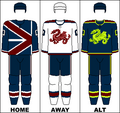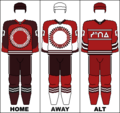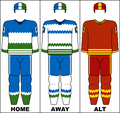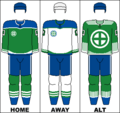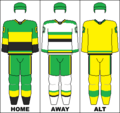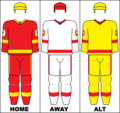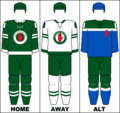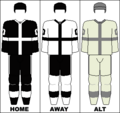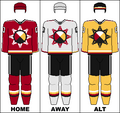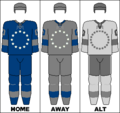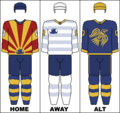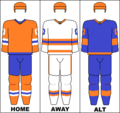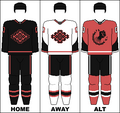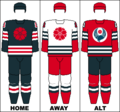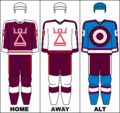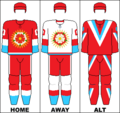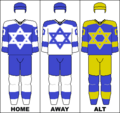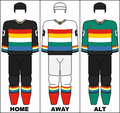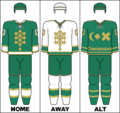Ajax Hockey Uniforms
This article is incomplete because it is pending further input from participants, or it is a work-in-progress by one author. Please comment on this article's talk page to share your input, comments and questions. Note: To contribute to this article, you may need to seek help from the author(s) of this page. |
Players participating in international ice hockey competitions are required to wear equipment to both protect the players and enable officials, players, and fans to easily identify them as a member of their respective team. Ice hockey uniforms have changed little since the game's creation, with minor changes over the years. Since 1980, WIHF rules have described a player's uniform to consist of: a hockey jersey, hockey pants, socks, gloves, and a helmet.
Uniform
Jersey
Hockey jerseys, or sweaters, are the primary means of identifying both an individual player and that player's team. Most jerseys feature a team's logo, or national hockey association logo, in the center of the chest and at times secondary logos on the shoulder. All jerseys in international competition require a player's number and surname featured on the back. Team captains and alternate captains also wear an additional patch on their jersey with a "C" or "A" located on the front of their jersey.
Traditionally, teams have a home and road jersey, wearing their dark jersey for home games and white for road games. Since the 1990s, many national teams have begun to wear third, or alternate, jerseys in select competitions. These alternate jerseys are often times less traditional, or more experimental, than the typical home and road kits.
Pants and socks
Hockey pants are knee-length shorts that provide protective padding to the upper legs, thighs, and tailbone. Hockey pants are often fashioned to fit the color and style of a teams jersey set. From the late 1970s to the early 1990s, teams began to experiment with waist-to-ankle pants. During this era, players continued to wear the same equipment underneath the extended pants shell. However, after a series of injuries and reviews that deemed the waist-to-ankle pants a risk to player safety, they were banned in 1992.
Hockey socks are made of wool or a lightweight, stretch material that are worn over the shin guard and are worn on the outer later of the uniform. They are not to be confused with traditional socks, which may or may not be worn underneath protective equipment and skates.
Protective equipment
WIHF had required athletes to wear helmets in all international competitions since 1977. Upon the rule change, players already on the roster of their national team were grandfathered in, and were not required to wear a helmet so long as they remained on the national team roster. The last player to participate in a WHIF sanctioned competition without a helmet was [name] of [nation]. Face shields or visors were first introduced in the 1980s, and have grown in prominence ever since. These visors only protect the eyes. While there are currently discussions to require all players to wear visors during competition, there is currently no requirement. Full cage face shields are banned from international competition, unless the individual is under the age of 16. In competition, all players wear matching color team helmets.
Along with team uniforms, players are required to wear protective equipment both underneath and outside of the team uniform. Underneath the jersey, players are required to wear shoulder pads, which cover the player's chest, shoulders and upper back; elbow pads which can also protect the forearm. Underneath hockey pants, players wear a jockstrap to protect their genitals. While some players may choose to wear a girdle underneath their hockey pants to hold their hockey socks in place, most modern jockstraps incorporate the girdle in the form of velcro strips to attach to hockey socks. Players also wear shin guards beneath their hockey socks, which cover the player's lower leg from their need to their ankle.
Gallery
A list of ice hockey uniforms used by national teams during the World Ice Hockey Tournament.
- EnyamaHockey.png
